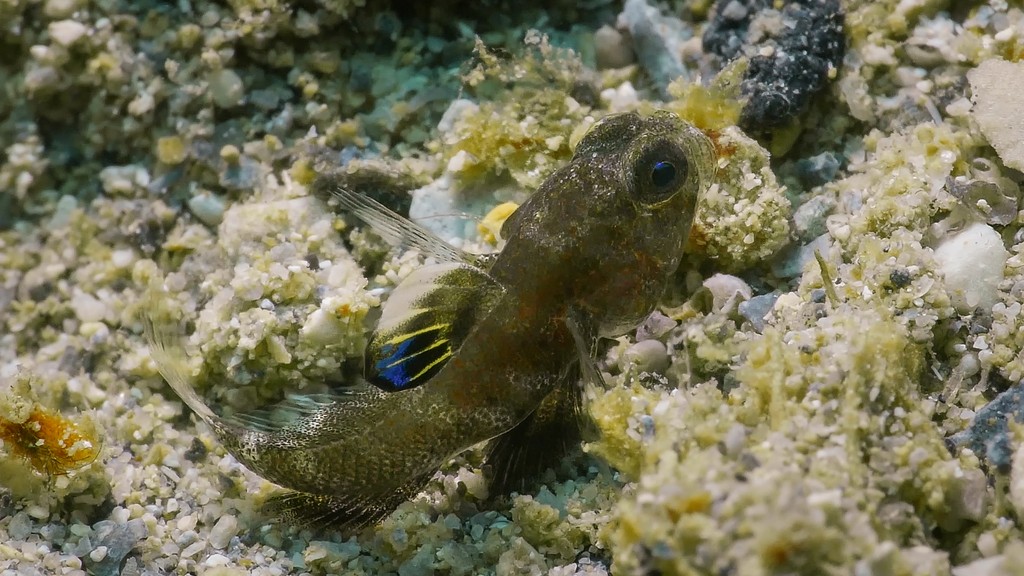MAHIDOLIA MYSTACINA - (VALENCIENNES, 1837)
Actinopterygii (Gigaclass) > Actinopteri (Class) > Teleostei (Subclass) > Gobiiformes (Order) > Gobioidei (Suborder) > Gobiidae (Family) > Gobiinae (Subfamily) > Mahidolia (Genus)
Gobie à moustaches, Flagfin prawn goby, Flagfin shrimpgoby, Smiling goby, Glimlag-dikkop, Kasurihaze, カスリハゼ, 帆鳍鰕虎, 大口巨颌鰕虎鱼,
Synonymes
Gobius maxillaris (Macleay, 1878)
Gobius mystacina (Valenciennes, 1837)
Gobius mystacinus (Valenciennes, 1837)
Gobius pulverulentus (Kuhl & van Hasselt, 1837)
Mahidiolia duque (Smith, 1947)
Mahidiolia normani (Smith & Koumans, 1932)
Mahidoria mystacina (Valenciennes, 1837)
Oligolepis fasciatus (Wu & Lin, 1983)
Rictugobius normani (Smith & Koumans, 1932)
Waitea buchanani (Rao, 1972)
Waitea mystacina (Valenciennes, 1837)
Waitea parvida (Tanaka, 1915)
----------------------------
Description
Fist dorsal spines (total): 6, and fin elongate in males (first 3 spines longest), triangular to rounded in females; Second dorsal fin: 1 spine and soft rays: 10; Anal spine: 1; Anal soft rays: 9; Pectoral fin rays: 16-17. Body scales ctenoid, reaching forward to gap between dorsal fins; Predorsal area and sides of head naked; United pelvic fins, frenum present; Lateral scale series: 33-39; Transverse rows of scales backwards: 13-14. Head and body compressed; Mouth greatly enlarged, jaws reaching to lower rear corner of preopercle in adult males. Eyes large, dorsolateral. No anterior interorbital pore; Sensory papillae on head in transverse pattern. Head without scales; Greatest depth of body: 3.9-4.4 in SL; Rounded caudal fin, about equal to head length. Max. length: 8.0 cm TL. Depth range: 5 - 25 m, usually: 5 - 20 m.
Color
Several color forms known (brown, blue and yellow); Head and body usually pearly grey to brown, with 8-10 anteriorly oriented oblique broad brown bands and scattered fine blackish spots; Head and nape spotted and marbled with orange, yellow or blue; First dorsal fin with ocellate black spotting (in males) or with broad alternating pale and dark bands (in females).
Etymology
Mahidolia: the genus is named in honor of His Royal Highness Prince Mahidol of Songkla, deceased, in appreciation of his substantial interest in the fishes and Fisheries of Siam. This interest was manifested in various ways, notably by the setting aside of a large fund for sending young Siamese abroad for special training in fishery work.
mystacina: from Latin, mystax = upper lip, mustache. In 1837, Valenciennes call this fish, mustache Goby.
Original description: Gobius mystacinus Valenciennes, 1837 - Type locality: Java, Indonesia.
Distribution
Red Sea; Indo-West Pacific: East Africa and Madagascar, east to Micronesia and Samoa, north to southern Japan, south to northern Australia and New Caledonia.
Biology
Occurs in silty coastal bays. Enters estuaries and freshwater tidal zone habitats. Found on muddy bottom at the base of the reef. In burrows with alpheid shrimps.
Last update: 13, September 2024
Gobie à moustaches, Flagfin prawn goby, Flagfin shrimpgoby, Smiling goby, Glimlag-dikkop, Kasurihaze, カスリハゼ, 帆鳍鰕虎, 大口巨颌鰕虎鱼,
Synonymes
Gobius maxillaris (Macleay, 1878)
Gobius mystacina (Valenciennes, 1837)
Gobius mystacinus (Valenciennes, 1837)
Gobius pulverulentus (Kuhl & van Hasselt, 1837)
Mahidiolia duque (Smith, 1947)
Mahidiolia normani (Smith & Koumans, 1932)
Mahidoria mystacina (Valenciennes, 1837)
Oligolepis fasciatus (Wu & Lin, 1983)
Rictugobius normani (Smith & Koumans, 1932)
Waitea buchanani (Rao, 1972)
Waitea mystacina (Valenciennes, 1837)
Waitea parvida (Tanaka, 1915)
----------------------------
Description
Fist dorsal spines (total): 6, and fin elongate in males (first 3 spines longest), triangular to rounded in females; Second dorsal fin: 1 spine and soft rays: 10; Anal spine: 1; Anal soft rays: 9; Pectoral fin rays: 16-17. Body scales ctenoid, reaching forward to gap between dorsal fins; Predorsal area and sides of head naked; United pelvic fins, frenum present; Lateral scale series: 33-39; Transverse rows of scales backwards: 13-14. Head and body compressed; Mouth greatly enlarged, jaws reaching to lower rear corner of preopercle in adult males. Eyes large, dorsolateral. No anterior interorbital pore; Sensory papillae on head in transverse pattern. Head without scales; Greatest depth of body: 3.9-4.4 in SL; Rounded caudal fin, about equal to head length. Max. length: 8.0 cm TL. Depth range: 5 - 25 m, usually: 5 - 20 m.
Color
Several color forms known (brown, blue and yellow); Head and body usually pearly grey to brown, with 8-10 anteriorly oriented oblique broad brown bands and scattered fine blackish spots; Head and nape spotted and marbled with orange, yellow or blue; First dorsal fin with ocellate black spotting (in males) or with broad alternating pale and dark bands (in females).
Etymology
Mahidolia: the genus is named in honor of His Royal Highness Prince Mahidol of Songkla, deceased, in appreciation of his substantial interest in the fishes and Fisheries of Siam. This interest was manifested in various ways, notably by the setting aside of a large fund for sending young Siamese abroad for special training in fishery work.
mystacina: from Latin, mystax = upper lip, mustache. In 1837, Valenciennes call this fish, mustache Goby.
Original description: Gobius mystacinus Valenciennes, 1837 - Type locality: Java, Indonesia.
Distribution
Red Sea; Indo-West Pacific: East Africa and Madagascar, east to Micronesia and Samoa, north to southern Japan, south to northern Australia and New Caledonia.
Biology
Occurs in silty coastal bays. Enters estuaries and freshwater tidal zone habitats. Found on muddy bottom at the base of the reef. In burrows with alpheid shrimps.
Last update: 13, September 2024
